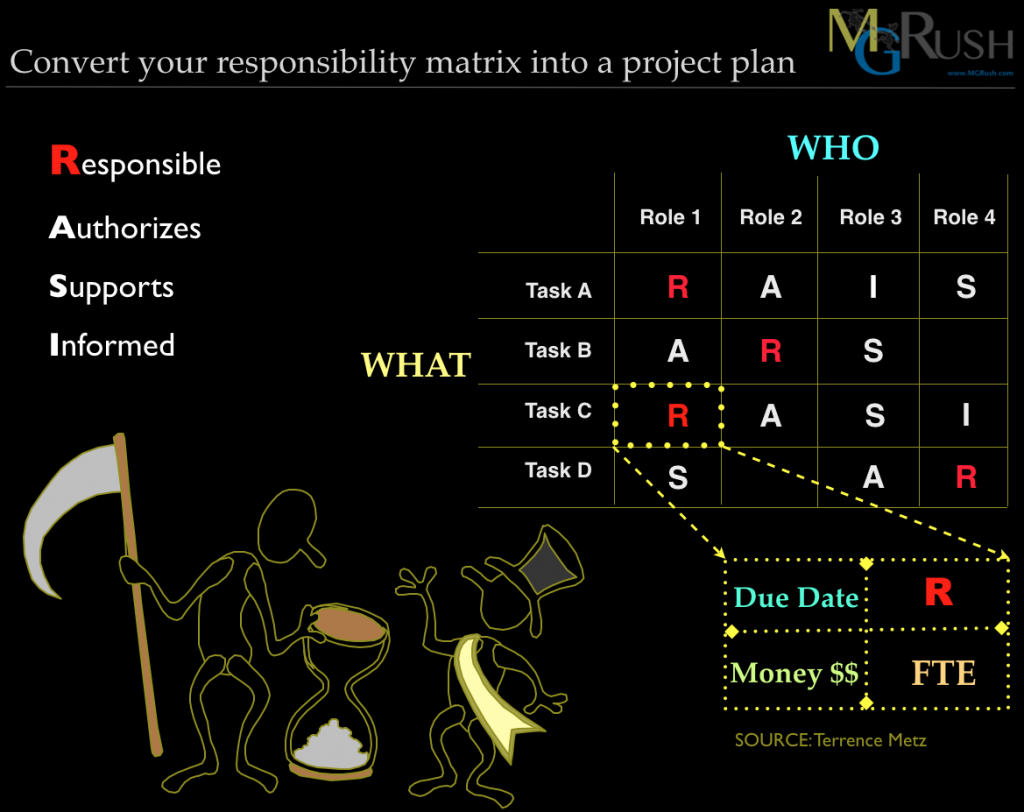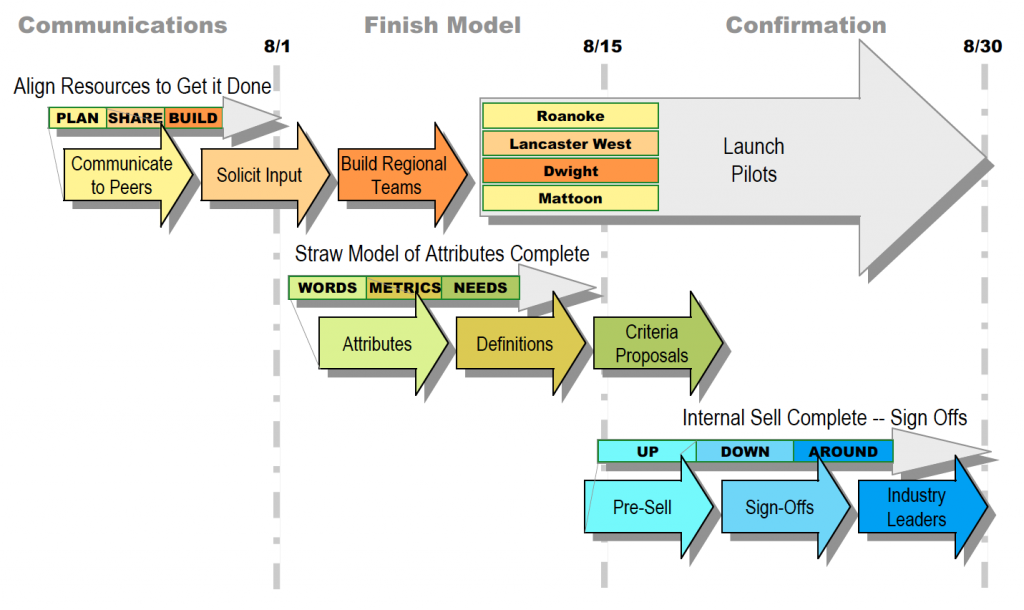Here’s how to create a project plan or RACI chart (or RACI matrix) when your discussion or meeting deliverable includes assignments for actions that have been built or identified.
As a result of capturing the additional inputs below, you develop a consensual understanding from your group’s roles and responsibilities chart (RACI chart).
(1) WHO will take responsibility (the keystone of a RACI chart or RACI matrix) for
(2) WHAT needs to be done (ranging from simple activities to comprehensive strategies) and
(3) WHEN the assignment(s) may be completed, given resources such as
(4) HOW MUCH extra money (approximate cash or assets) required and
(5) HOW MUCH estimated labor (FTP, or full-time person) is required to complete the assignment?
Method for Building a Roles and Responsibilities Matrix[*]
The WHAT group of actions or assignments may take the form of strategies, initiatives, programs, projects, activities, or tasks. They should already be identified before beginning your RACI or RASI assignments. Furthermore, as you increase the resolution from the abstract (eg, strategy) to the concrete (eg, task), expect to increase the resolution of the role or title of the responsible party. For example, strategies may get assigned to business units while tasks get assigned to individual roles such as Business Analyst or Product Owner.
Remember that the WHO dimension might include business units, departments, roles, or people but be consistent and match closely to the appropriate level of responsibility for WHAT needs to be done. Define each of the (five) areas of responsibility—note that each implies the others that follow. For example, the Authorizer is also Responsible. Hence, because they Support the effort, they need to be Informed about it as well.
- A = Authorizes—approves or signs off on the method or results of a given task
- R = Responsible—is held responsible for the success and completion of a given task
- S = Supports—provides assistance, information, etc., in the completion of a task—if requested
- C = Consults—provides consultation as required
- I = Informed—is kept informed of the progress or results of a given task.
- L = Lead (a surrogate or substitute for R)
Rules to Follow When Building a Roles and Responsibility Matrix
Especially relevant, note that C, or Consults has been de-emphasized with a blue font because “consults” can be a nebulous term. Our advice suggests substituting the S because it implies both Supporting and Being Informed.
Consider building your RACI chart or matrix using a large sheet of paper. Use a bright color marker, red is optimal, to document the R. Go back and complete the other relationships as appropriate.
- Portrait view—When using an easel or flip chart, write the people involved (units, job names, etc.) across the top (the WHO) and the tasks, jobs, projects, etc., down the left-hand side (the WHAT).
- Landscape view—Build a matrix on a whiteboard or other large writing area with the tasks, jobs, projects, etc. (the WHAT) across the top and the people involved (units, job names, etc.) down the left-hand side (the WHO).
- One and only one R per row (i.e., for each activity)
- At least one A who is not the R—may be more than one
- When this role requires only to be informed
- S for those supporting the R
NOTE:
- A implies R, S, I
- R implies S, I
- S implies I
Because this approach develops input for a Gantt chart, you also build consensual understanding and shared ownership. Furthermore, a facilitated effort captures the group’s personality, not a lone myopic view from one person’s office or cubicle. A generic and illustrative Gantt chart follows, displaying activities and assignments supporting a faux product development project:
How to Build Roles and Responsibilities for Multiple Sites
Here is a roles and responsibilities matrix that can help you manage multiple sites. The following supports more complicated situations than the traditional RACI chart (or RACI matrix or its equivalent) discussed above.
Using the table above as an illustrative template, preview the content you need to facilitate and develop. The content is coupled with additional explanations of the column headings below that support multiple sites.
Activity or Task[*]
The first section provides details about the Activity or Task that needs to be assigned and completed. Since the details will not fit comfortably into a spreadsheet cell, code the cell and refer to another document with additional details. As the details may or may not be complete at the time of the assignment, there may be a separate individual or group who takes on the role of author and provides the details. When initially logged, the details are either complete (y for yes) or not (n for not).
Location
Since identical tasks may be carried out in multiple facilities, code the facilities in the Location section. There could be more than two facilities of course. If more than two, you might substitute “A” for all instead of “B” for both.
Who Does What
The WHO section captures who will be responsible for the activity or task at each respective location. If necessary, you can add an additional column indicating their backup or who may be supporting them.
Frequency
The Frequency section refers to how often the activity or task needs to be performed. The due date represents the completion of the activity or task. For repetitive activities or tasks, the coding shown suggests the following:
- W = weekly
- M = monthly
- Q = quarterly
- A = annually
- V = variable or ad hoc
FTP or Full-time Person
The last section captures the intensity or concentration of effort required to complete the task. While frequently shown as hours per month, you could substitute FTP (i.e., full-time person-equivalent) or whatever measurement works best in your culture (aka FTE or full-time equivalent).
Finally, append the table with a resource column that estimates how much financial capital or currency will support the activity or task. This is a tool that you can modify to your situation, cultural expectations, and terms—so experiment freely.
A Roles and Responsibilities Matrix (RACI Chart) Captures WHO Does WHAT By WHEN
We have discovered at least twenty (20) different varieties of the Responsibility Matrix. While methodologically agnostic, we support any method your culture uses. However, be careful with the “C” as in ‘consult’. Because one can never be certain if an assigned “C” provides you something or you provide them something. Below you will find 20 documented types of roles and responsibilities, and undoubtedly there are others:

Transform Roles and Responsibilities Into a GANTT Chart
- ARCI
- RACI (Responsible, Accountable, Consult, Informed)
- RACIA (Approve)
- RASI (Supports)
- RASCI
- PARIS
- ALRIC
- RASCIO (Omitted)
- LACTI (Lead, Tasked)
- AERI (Endorsement)
- RACI-V
- CAIRO
- DRACI (Drives)
- DACI
- DRAM (Deliverables Review and Approval Matrix)
- RACIT
- RASIC
- RACI+F, where F stands for Facilitator
- CARS (Communicate, Approve, Responsible & Support)
- PACSI (Performed, Accountable, Control, Suggested & Informed)
[*] Moreover, for a thorough primer and clear discussion on RACI, see “RACI Matrix: How does it help Project Managers?”
______
Don’t ruin your career by hosting bad meetings. Sign up for a workshop or send this to someone who should. MGRUSH workshops focus on meeting design and practice. Each person practices tools, methods, and activities daily during the week. Therefore, while some call this immersion, we call it the road to building high-value facilitation skills.
Our workshops also provide a superb way to earn up to 40 SEUs from the Scrum Alliance, 40 CDUs from IIBA, 40 Continuous Learning Points (CLPs) based on Federal Acquisition Certification Continuous Professional Learning Requirements using Training and Education activities, 40 Professional Development Units (PDUs) from SAVE International, as well as 4.0 CEUs for other professions. (See workshop and Reference Manual descriptions for details.)
Want a free 10-minute break timer? Sign up for our once-monthly newsletter HERE and receive a free timer along with four other of our favorite facilitation tools.
Related video

Terrence Metz, president of MG RUSH Facilitation Training, was just 22-years-old and working as a Sales Engineer at Honeywell when he recognized a widespread problem—most meetings were ineffective and poorly led, wasting both time and company resources. However, he also observed meetings that worked. What set them apart? A well-prepared leader who structured the session to ensure participants contributed meaningfully and achieved clear outcomes.
Throughout his career, Metz, who earned an MBA from Kellogg (Northwestern University) experienced and also trained in various facilitation techniques. In 2004, he purchased MG RUSH where he shifted his focus toward improving established meeting designs and building a curriculum that would teach others how to lead, facilitate, and structure meetings that drive results. His expertise in training world-class facilitators led to the 2020 publication of Meetings That Get Results: A Guide to Building Better Meetings, a comprehensive resource on effectively building consensus.
Grounded in the principle that “nobody is smarter than everybody,” the book details the why, what, and how of building consensus when making decisions, planning, and solving problems. Along with a Participant’s Guide and supplemental workshops, it supports learning from foundational awareness to professional certification.
Metz’s first book, Change or Die: A Business Process Improvement Manual, tackled the challenges of process optimization. His upcoming book, Catalyst: Facilitating Innovation, focuses on meetings and workshops that don’t simply end when time runs out but conclude with actionable next steps and clear assignments—ensuring progress beyond discussions and ideas.






I like how you clearly show how to link the RACI to the Gantt chart in this post. One of the clearest examples I’ve seen.
Much appreciate you taking time to reply John. Thanks